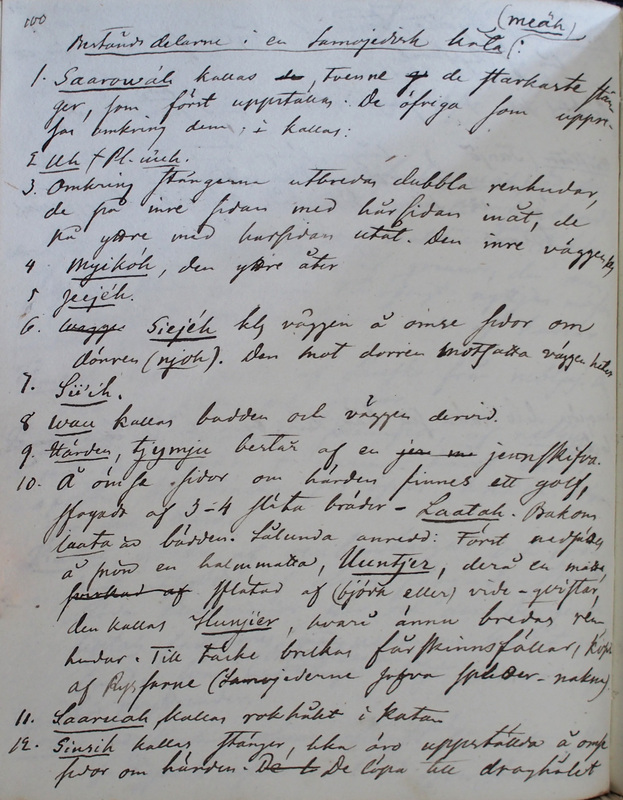Beståndsdelarne i en Samojedisk kåta
-
kallas tvenne de starkaste stån-
ger, som först uppställas. De öfriga som uppre-
sas omkring dem kallas:
- Uh. Pl.
Pl. u'uh.
- Omkring stångarna utbredas dubbla renhudar,
de på inre sidan med hårsidan inåt, de
på yttre med hårsidan utåt. Den inre väggen kls[kallas]
-
den yttre åter
-
-
kls[kallas] väggen å ömse
sidor om dörren
Den mot dörren motsatta väggen heter
-
-
kallas bädden och väggen dervid.
- Härden,
består af en jernskifva.
- Å ömse sidor om härden finnes ett golf,
sfogadt af 3-4 släta bräder -
Bakom
laata är bädden. Sålunda anredd: Förut nedsättes
å snön en halmmatta,
derå en matta,
sflätad af (björk eller) vide-qvistar,
den kallas
hvarå ännu bredas ren-
hudar. Till täcke brukas fårskinnsfällar, köpta
af Ryssarne (Samojederne sofva splitter-nakna).
-
-
kallas stänger, hka[hvilka] äro uppställda å ömse sidor om härden. De löpa till draghålet[rökhålet]
|
The parts of the Samoyed tent (meäh)
- Saarowáh. The two strongest poles are set up first. The rest arranged around them are called:
- Uh.
- Double reindeer skins are spread around the poles,
those on the inner side with the fur side facing inwards, those on the outside with the fur side facing outwards. The inner wall is called
- Myikóh, the outer
-
Jeejéh
- Siejéh, the wall on both sides of
the door (njoh).TN нë ʻdoor of the tent’ The wall opposite the door is called
- Sii'ih
-
Wau, the beds and the wall next to them.
- The hearth, tjymju consists of an iron plate.
- On both sides of the hearth there is a floor, three or four flat boards – Laatah – joined together. Behind the laata there are the beds. Made like this: first, a straw mat, Uuntjer is placed on the snow, and over it, a mat braided from (birch or) willow twigs; it is called Hunjier and the reindeer hides are set on it. Sheepskins, bought from the Russians, are used as blankets (the Samoyeds sleep completely naked).
- Saaruah, the smoke hole in the tent.
- Sinsih, the poles which are erected on each sides of the hearth. They go to the smoke hole.
|

